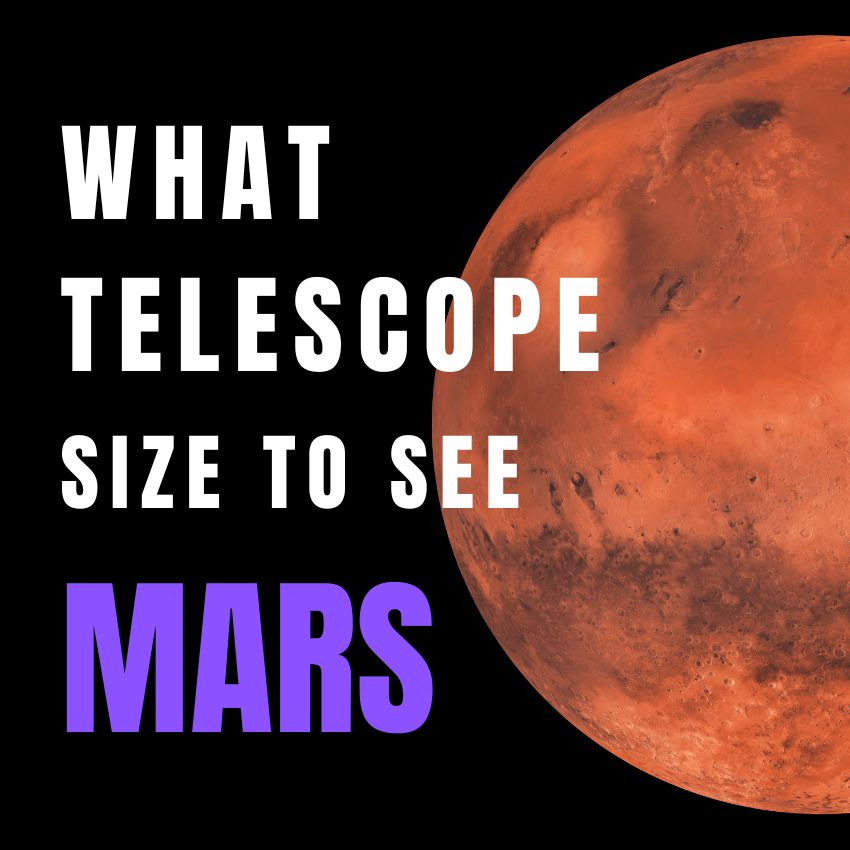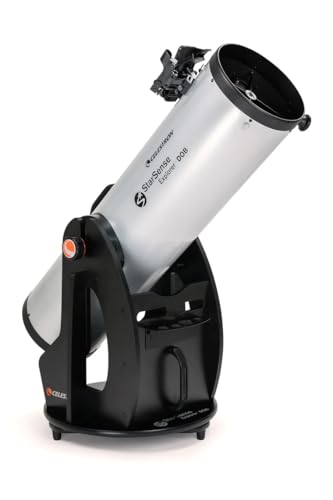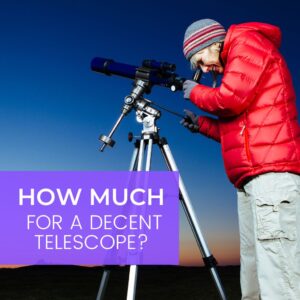This site contains affiliate links to products. I may receive a commission for purchases made through these links.
The telescope size you need to see Mars depends on what type of observer you are. A 4” – 6” telescope is fine for beginners/ casual observers, while a 6” – 8” is suitable for intermediate observers. Advanced observers who want to see more details need a telescope that’s 8” or larger.
The universe is fascinating, and Mars is one of the planets that makes it so. The planet is named after the Roman god of war because of its bloody red tone.
We can observe Mars from our home here on Earth. People who have been privileged to observe Mars are always amazed and intrigued by the red planet.
However, the experience of observing Mars is dependent on many factors, including the size of the telescope you use. With the wrong telescope, Mars could appear as an uninspiring red dot in the sky. But with the right telescope, it would be a spectacular red world.
In this article, we’ll answer the question, “what size telescope do I need to see Mars for the best results?” The discussion will reveal recommended telescope size for Mars observation and more.
Let’s get started!
Can you see Mars with any telescope?
Mars’ reddish hue and close orbit to the earth means it is sometimes discernable in the night sky, even with the naked eye. Thus, you can see the planet Mars with any telescope. However, the stronger the telescope, the more of the planet you’ll see.
When it comes to observing Mars, any telescope is better than no telescope. While it is sometimes possible to see Mars with the naked eye, a telescope will enhance the picture, allowing you to see more of the planet.
Many times, Mars is too far away to reveal much detail. The best time to observe the planet is when it’s closest to the Earth because it’s the biggest and brightest in the sky at this time.
This is when the planet is in opposition (appears opposite the sun in the sky). The days and weeks immediately before and after opposition are also excellent times for viewing Mars through a telescope.
On a night of good viewing, even a small telescope will reveal the most prominent features on the Martian surface.
Does the aperture size of a telescope affect Mars’ observation?
A telescope’s aperture size determines its resolution. The bigger the aperture size, the better its resolution. So, a bigger aperture telescope makes images brighter and sharper, allowing you to see more details when observing Mars.
A telescope’s aperture is the diameter of the light-collecting region. The larger the region, the more light the telescope can gather and bring to its eyepiece or camera.
Gathering more light increase a telescope’s resolving power. Thus, a larger aperture increases a telescope’s ability to show fine details.
In fact, increasing the aperture size is usually the easiest way to improve the observation of faint objects. So, to get the best results when observing far-away Mars, consider a telescope with as large an aperture as you can afford and handle.
The 40-inch telescope at the Yerkes Observatory is the largest aperture-refracting telescope in the world.
Factor to consider when choosing a telescope for Mars observation
When choosing a telescope to view mars, some of the things to consider are:
- Magnification
- Aperture
- Quality of optics
- Mount type
- Budget
Magnification
Magnification is how much a telescope enlarges its subject. The higher a telescope’s magnification, the larger picture it gives of its subject. So, when viewing Mars, the higher the magnification, the better.
Since Mars is far away in the sky, you’ll see it as a very small astronomical object. To have a good view of the planet, you need a telescope with a very high magnification that effectively enlarges the picture.
Aperture
The aperture determines the telescope’s resolution. The larger the aperture, the more light the telescope collects to create sharper pictures.
So, if you want to see the fine details of Mars, you need a telescope with a large aperture.
Quality of optics
The quality of optics is how well a telescope can focus the light it collects.
A larger aperture means the telescope can gather more light. But the telescope must focus collected light on the eyepiece to create clear pictures.
If a telescope has poor-quality optics, it cannot optimally focus collected light to produce sharp images.
That said, optical quality is important because a powerful telescope with high magnification and a large aperture will not give a clear view of Mars if it has poor-quality optics.
Mount type
Telescope mounts are now more sophisticated than support bases where you place your telescope. There are two types of telescope mounts – Alt-Azimuth mounts and Equatorial mounts.
A telescope mount now doubles as a tracking device that helps you keep the object you’re viewing in the field of vision as Earth continues to turn.
So, the type of mount you get determines whether or not you’ll get precise tracking when observing and taking long-exposure pictures of celestial bodies.
You may also read: Alt-Azimuth Mount vs Equatorial Mount (Which is best for you?)
Budget
The more powerful a telescope is, the more expensive it’ll be. So, when choosing a telescope, you also need to check whether or not it fits your budget.
The three most common types of telescopes are reflectors, refractors, and catadioptrics. Each type differs in terms of power, with the more powerful ones available at higher price points.
For example, the reflectors are not as powerful as the other two types, so they’re the cheapest. Reflectors are good options for aspiring Mars observers who are on a budget.
The refractors are more powerful than reflectors and so are more expensive. They are good options if you want a very powerful telescope but do not want to pay over the top.
The catadioptrics is the most powerful telescope and, therefore, the most expensive.
Recommended telescope sizes for Mars observation
The size of a telescope refers to the diameter of its aperture. The recommended telescope size for viewing Mars depends on whether you are a beginner, intermediate, or advanced observer.
A 4 – 6 inches telescope is suitable for beginners/ casual observers who may just want to make out major Martian features. A 6 – 8 inches telescope will satisfy intermediate observers’ need to see more noticeable dark features, while a powerful 8+ inches telescope is required by advanced observers who need to see more details on the planet’s surface.
Beginner/ casual observer: 4 – 6 inches
Beginners or casual observers are usually fascinated by making out the distinct red disc of Mars and some of the Martian surface features.
A small telescope of 4 – 6 inches is powerful enough to see the planet’s distinct red color and its major dark surface areas. The telescope also lets you see the Martian polar caps (albeit they appear really small).
You can’t go wrong with the 4” Sky-Watcher EvoStar 100 APO Doublet refractor. It provides super contrast, helping you to see Martian features clearly.
Intermediate observer: 6 – 8 inches
Intermediate observers always want to see more noticeable dark features on the red planet, making a 6 – 8 inches telescope more suitable.
With an aperture range of 6 – 8 inches, the red color of Mars is more pronounced, and the polar ice caps are clearer and bigger. You’ll also see more dark patches on the Martian surface.
An excellent intermediate telescope is the Celestron NexStar 8SE telescope. With its 8-inch aperture, it has a fantastic light-gathering ability to deliver sharp images for intermediate to advanced stargazers.
Advanced observer: 8 inches or larger
Advanced observers want to get as many details as possible when viewing the red planet. Thus, an advanced observer needs a more powerful and larger telescope (not smaller than an 8 inches aperture).
A powerful telescope will reveal an incredible amount of surface detail. It lets you see finer details of the three Martian surface albedo – dark regions, bright orange-red regions, and bright white polar caps.
A perfect example is the Celestron–StarSense Explorer 10-inch Dobsonian Smartphone App-Enabled Telescope.
What is the best telescope magnification to view Mars?
To see most of Mars’ surface features, you should use 30 – 50x magnification.
When viewing Mars, the higher the magnification, the better. So, for the best viewing experience, use your telescope’s maximum useful magnification.
A telescope’s maximum useful magnification is 50x its aperture size in inches or (2x the aperture in millimeters). Thus, the maximum useful magnification of this 8 inches NexStar computerized telescope is 400.
Using the optimal useful magnification (50 aperture) is not often possible. So, when viewing Mars, it’s good to try for a magnification of 30x – 50x aperture size.
To know the magnification of your telescope, divide its focal length by the eyepiece’s focal length. Magnification = telescope’s focal length ÷ eyepiece’s focal length.
What can I see on Mars with a small telescope?
Mars is distinct in the night sky. While stars will appear as shining pinpricks, Mars appears as a red disc.
Mars is the only planet whose surface features can clearly be seen from Earth. Under ideal conditions, you can see much of Mars’ surface, even with a small telescope.
Around opposition, even with a small telescope, you can see the following:
A polar cap
During Martian northern and southern winters, polar ice caps forms at the planet’s poles, consisting of a layer of frozen carbon dioxide and water ice.
With a small telescope, you can see at least one polar cap, appearing as white coloration at the top and bottom of the red planet.
Syrtis Major
It’s one of the two major darker regions of Mars. It was formerly thought to be a sea. So, it’s named after the Gulf of Sidra off the coast of Libya.
Syrtis Major is a wedge-shaped dark area (near the equator) pointing towards the north pole.
Mare Acidalium
It’s the second of the major darker regions of Mars. Mare Acidalium is named after a legendary fountain. It is located in the north of Mars and extends southwards.
Elysium Planitia
It’s one of the red-orange regions of Mars, formerly thought to be continents. It’s a broad plain that straddles the equator of the red planet.
Chryse Planitia
This is where the first US spacecraft to Mars landed. It’s another of the lighter Mars regions. It’s a smooth circular plain in the northern equatorial region of Mars.
Dust storms
Mars’ thin atmosphere can cause dust storms. You can see these storms with a small telescope. However, you won’t want to see Martian dust storms because they can completely obscure the planet’s surface, depriving you of seeing all of Mars’ glory.
With a more powerful telescope, you’ll see more striking features on Mars including:
Cloud
Mars has thin water-ice clouds which are visible with a powerful telescope.
Olympus Mons
Olympus Mons is a large shield volcano on Mars. In fact, it’s the tallest volcano in the solar system (towering about two and a half times Mount Everest’s height above sea level).
Valles Marineris
It’s a large canyon system, which is deeper and longer than the Grand Canyon.
Martian Moons
Mars has two moons – Phobos and Deimos – and if you use a powerful telescope, you may be lucky enough to detect them orbiting the red planet.
Where do I find Mars in the night sky with a telescope?
Mars lies in the constellation Taurus, just north and west of Orion.
People who have not been following Mars since the 2022 opposition can use star charts and sky maps in astronomy magazines and websites to locate Mars in the night sky.
How do I get the best views of Mars with a telescope?
To get the best view of Mars when observing the planet through a telescope, you need to do the following:
Observe Mars during its closest approach to Earth
As Mars orbits the sun, its position relative to the earth constantly changes.
Mars’ features are more visible when it is closest to the earth than when it is far away. Thus, the best time to observe Mars is during its closest approach to Earth.
Mars is closest to earth when it is in opposition (or appears opposite the sun in the sky).
Mars’ latest closest approach to earth was on December 8, 2022, when it got to 0.5492 AU distance from earth. The red planet’s closest approaches in the near future will be:
- January 16, 2025 (0.6435 AU distance)
- February 19, 2027 (0.6780 AU distance)
Use a telescope with a large aperture for the best view of Mars
The larger your telescope’s aperture, the more light it gathers and the higher its resolving power.
The higher the resolution of your telescope, the clearer, and sharper its pictures. So, if you want to see the fine details of the Martain surface, you need a telescope with a large aperture.
The Orion 8945 SkyQuest XT8 Classic Dobsonian Telescope is a powerful telescope that is easy to use because of its Dobsonian design. Importantly, it’s the perfect large-aperture low-budget telescope.
Use high-quality eyepieces and a Barlow lens
The eyepiece is the part of the telescope that magnifies the image produced by the microphone’s objective. A high-quality eyepiece helps you achieve useful magnification so that the human eye can see the image.
Using a Barlow lens is one of the easiest ways to increase the magnification of your telescope. A Barlow lens increases the focal length of a telescope by reducing the convergence of the light cone heading toward the eyepiece.
Since a telescope’s magnification is determined by dividing the focal length by the eyepiece’s focal length, increasing the focal length increases the magnification.
You may also like The Best Barlow Lens For Any Telescope (Buying Guide)
Use filters to enhance the view of specific features on the Martian Surface
A telescope’s filter improves contrasts and enhances details by “filtering” out unwanted colors or wavelengths.
Know that light pollution is a real killer when viewing Mars. Filters help you see Martian features in greater detail by filtering out unwanted light. For example:
- Red (#23A, #25, #29) filters enhance fine surface details, allowing you to see dust clouds and polar cap boundaries clearly.
- Blue (#38A, #80A, #82A) filters enhance clouds, helping you make out discrete white clouds, equatorial cloud bands, etc.
That said, investing in filters will help you get the best views of Mars with a telescope.
Properly align and focus your telescope before observing
You will see blurry images if your telescope is not properly aligned. So, to get clear views of Mars, you need to properly align your telescope before viewing. You can easily do this using a bright star in a dark sky.
- Focus your telescope on a very bright star in the sky
- Center the star in the field of view, and zoom in on it as much as possible
- Then slowly defocus the star, ensuring a pattern of concentric circles appears around it.
Use a motorized equatorial mount for tracking Mars
As the earth turns, an astronomical object you are observing can go out of your telescope’s field of vision. A motorized equatorial mount prevents this.
The motorized equatorial mount is an advanced mount that helps you keep Mars in your telescope’s field of vision for long-exposure astrophotography.
One perfect equatorial mount for tracking Mars is this Celestron CGX Computerized German Equatorial Mount and Tripod.
Take a series of images of Mars over time to watch any changes in its surface features
Like the Earth, Mars rotates about its axis as it orbits the sun. So, the view of the planet from your observing position changes slightly from night to night.
A Mars day lasts 37 minutes longer than an Earth day. So, Mars appears to rotate slowly from east to west, revealing all its surface features.
Thus, to get the best results, you should take a series of images to see the changes in the planet’s surface features over time.
Observe Mars in the early evening when it is higher in the sky and the air is more stable
The best time to observe Mars is when it is at its highest point in the sky. The red planet is brightest at its highest point in the sky, allowing you to explore more of its surface features.
In the few weeks after opposition, Mars appears higher in the sky in the early evenings.
However, this does not mean you’ll get the best viewing result in any evening. Nights with steady air are best for viewing Mars.
A turbulent atmosphere will make Mars appear as a boiling reddish blob in the telescope. But in a steady atmosphere, you can see its finer details.
Join an online observing group or club
Astronomy is more fun when you do it with like-minded people. In an observing group or club, you’ll find people ready to share their knowledge of the sky.
You’ll learn new techniques and discover new equipment to help you get richer images when viewing Mars. So an observing group is one of the best resources for developing your skills in astronomy.
A popular astronomy club is the Virtual Astronomy Club. They’ll guide you through everything, from setting up your telescope to discovering galaxies and nebulae. We like their detailed monthly guides and challenges to attempt.
The Griffith Observatory in Los Angeles is another space to follow for great Mars viewing experiences. They host special events that connect people to special sights in the sky.
You may also like: How Big of a Telescope Do You Need to See Saturn’s Rings?
Takeaway – Explore the fascinating red world of Mars
You can see Mars with your naked eye. However, a telescope gives a better experience as it enhances the image, turning it from an uninspiring red disc to a fascinating feature-filled world.
You can see major features on Mar’s surface with a small telescope. But you need a powerful telescope to see the planet’s finer details.
A 4 – 6 inches telescope is fine for beginners/ casual observers. A 6 – 8 inches telescope is suitable for intermediate observers. While advanced observers need a telescope that’s 8 inches or larger.
Important factors to consider when choosing a telescope for exploring the fascinating red world of Mars include magnification, aperture, quality of optics, mount type, and budget.
Read also:








